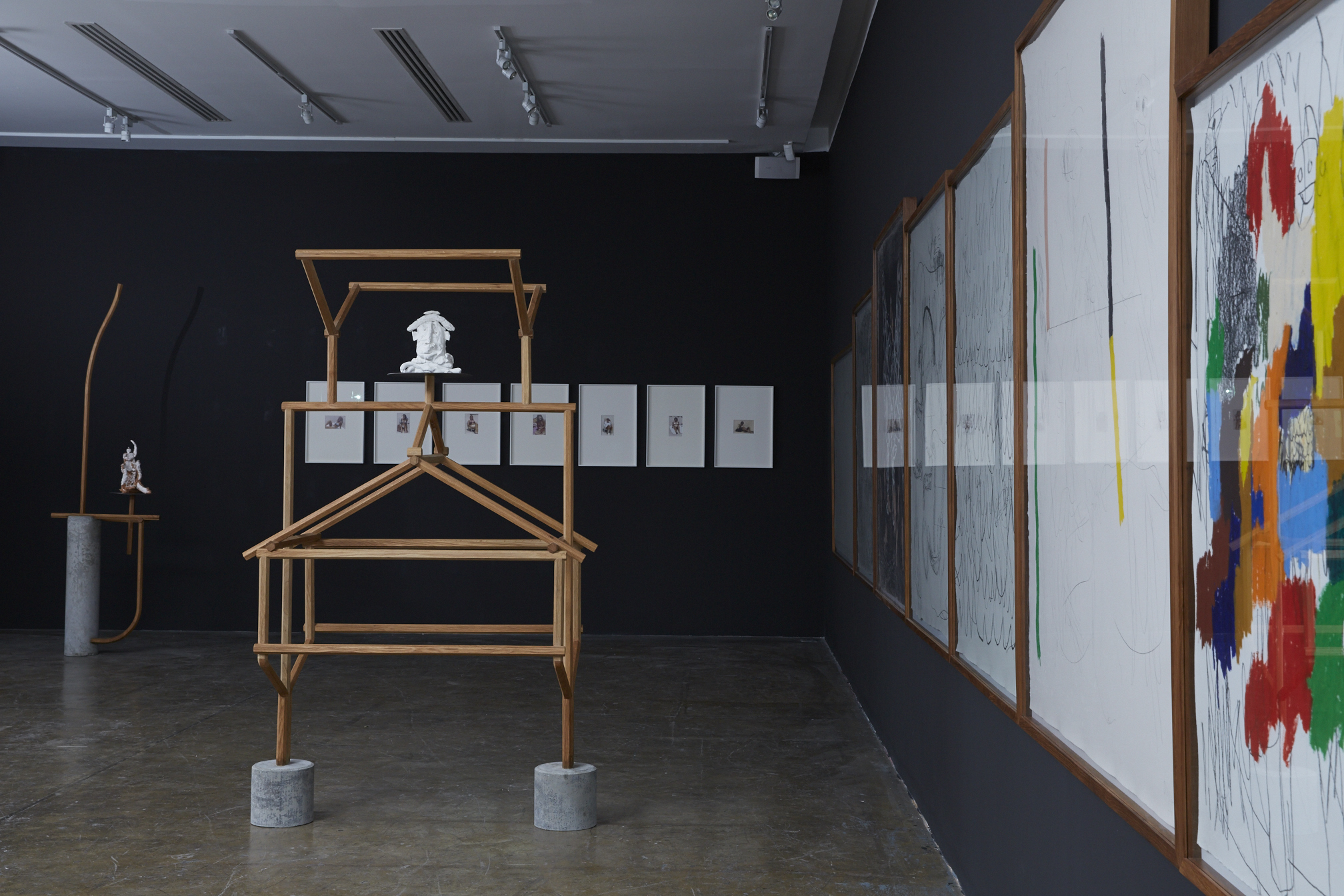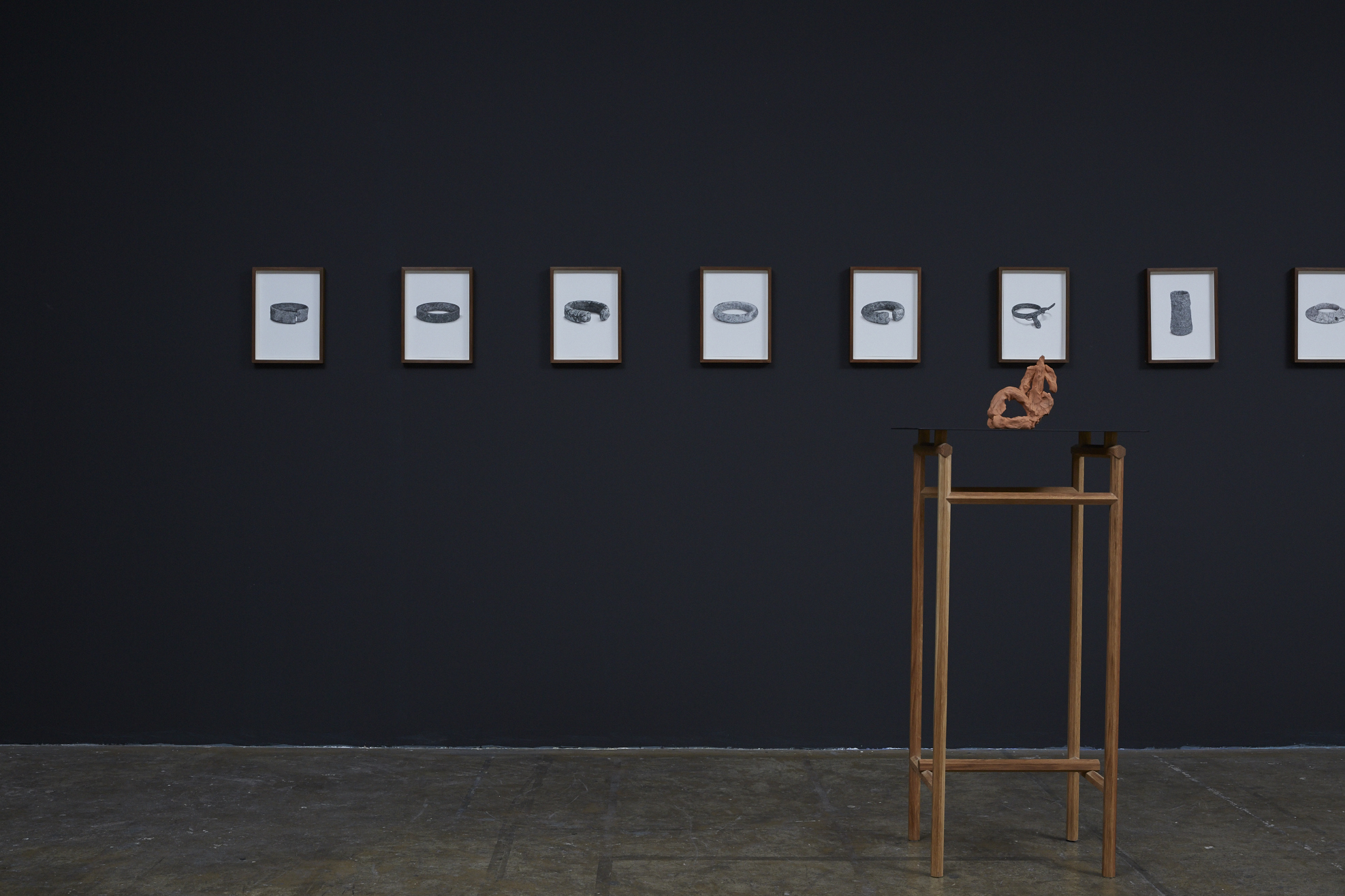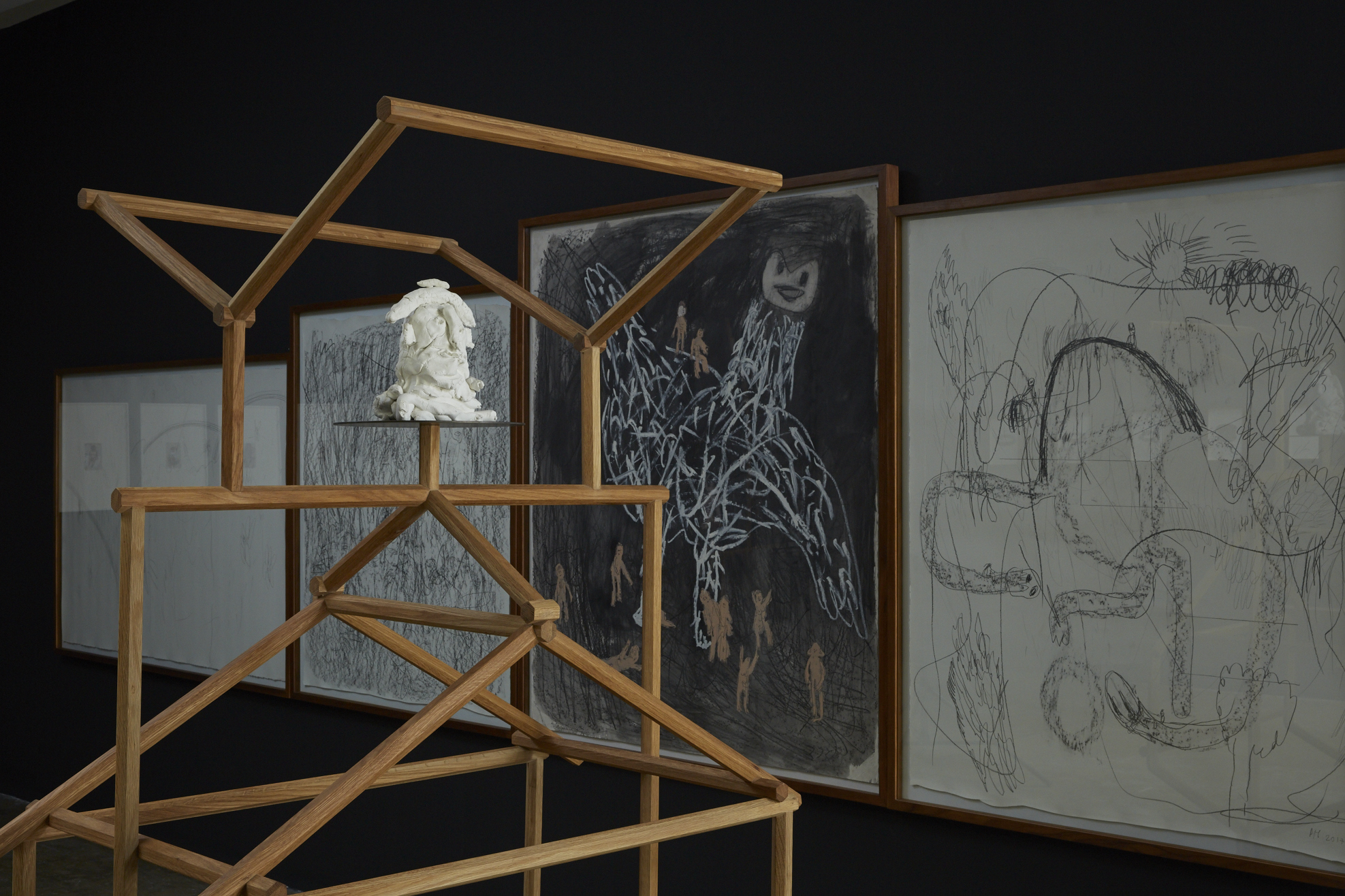Dusadee Huntrakul utilized shit as the hyperlink in his recent show, creating a connection between artworks and information elsewhere

The hyperrealistic elements of the sketches of Ban Chiang bracelets and the image of a Caucasian woman sunbathing in a bikini make the disfigured mass and the abstractness of the drawing and paintings stand out from other pieces of art being displayed in the exhibition room. After taking another look, we see that the seemingly deformed mass is not exactly abstract simply because it’s perfectly accurate for a pile of shit to look that formless.
Dusadee Huntrakul took excrement from a toilet and put it on display on a podium designed by Flo in order for it to be right at human eye level as the digested and discharged mass leads viewers to many other different stories, including the artist’s personal observation about his own ability to create sculptures of such form. “For me, this is a dialogue. I once created a pile of feces from sand and a fly actually landed on it. I made a gecko shit and the next day a gecko took a dump next to it. It’s communication through forms.” He also questions why feces are perceived as something so horrid that we feel the need for them to be put away out of our sight. “If we readjust the symbolic meaning of shit, the society will look at it from different perspectives such as that of urban waste management whose meaning would be turned upside down.” The issue was extended to our culture where humans are derogatorily compared to shit or animals. The artist views such culture as dehumanizing like the way a person with a political ideology in this country is referred to as a ‘red buffalo.’
You can probably guess by now that ‘There are More Monsoon Songs Elsewhere’ is not the kind of exhibition where stories are told straightforwardly. The artist outlines a structure of relationships as viewers are left to connect all the dots. The same story goes for Artefacts, 2007, an image of women sunbathing in a bikini and ‘There are More Monsoon Songs Elsewhere,’ 2018, a sketch of Ban Chiang bracelets, which share a common quality of a found object.
“My guess is that the person who took the picture (Artefacts) was this pervy guy who carried around his camera and took pictures of girls at beaches so that he could use them to masturbate with at home.” The accidental finding of this unidentified image stimulates some basic questions like who took the picture, where it was taken and who was the girl in that photo? The artist’s speculation, which is considered a form of interaction between viewers and the image they are looking at, reaffirms one of the most distinctive characteristics of found objects, and that is that they are open to interpretation. Nevertheless, the bikini lady photograph and ancient bracelets sketches are somewhat more special than most found objects. While both ‘There are More Monsoon Songs Elsewhere’ and ‘Artefacts’ give out the vibe of conceptual photography, simply because the artist transformed their status as a historical object into something else through the process of replication, such approach leads to a pretty messy combination with the exhibition’s grand narrative and individual history becoming all tangled up, not to mention the works’ loose connection with Flo’s furniture and its status as a ‘contemporary object’ (especially when considering the fact that the works are freshly made replicas that the artist created less than a year ago). “It has something that overlaps with design as well if we count Ban Chiang bracelets as this pre-historic work of product design. It relates to Flo’s furniture, which is a work of product design created in this present time as well,” said Huntrakul.


ความ hyperrealistic ของภาพสเก็ตช์กำไลบ้านเชียง และภาพถ่ายฝรั่งใส่บิกินีอาบแดดบนชายหาด ทำาให้ก้อนเละๆ และความนามธรรมของดรอว์อิ้งและประติมากรรม โดดออกมาจากงานชิ้นอื่นในห้องนิทรรศการ แต่เมื่อมองดูดีๆ อีกครั้ง ก้อนเละๆ ที่ว่าก็ไม่ได้ abstract แต่อย่างใดเพราะเป็นเรื่องถูกต้องอยู่แล้วที่ก้อนขี้จะไร้รูปทรงแบบนั้น
ดุษฎี ฮันตระกูล นำาก้อนขี้จากใต้โถส้วมขึ้นมาวางไว้ในระดับสายตา บนแท่นวางที่ถูกออกแบบโดย Flo เพื่อให้ขี้เชื่อมโยงไปสู่เรื่องราวอื่นๆ อีกหลายเรื่อง ทั้งเรื่องส่วนตัวที่ศิลปินบอกกับ art4d ว่าเขาค่อนข้างถนัดปั้นของที่มีฟอร์มแบบนี้ “สำหรับผมสิ่งนี้เป็นเหมือน ‘บทสนทนา’ ครั้งหนึ่งผมเคยปั้นขี้ด้วยทรายแล้วมีแมลงวันบินมาเกาะ อีกครั้งหนึ่งผมลองปั้นขี้จิ้งจกวางไว้แล้ววันต่อมาก็มีจิ้กจกมาขี้ข้างๆ มันเป็นการสื่อสารด้วยฟอร์ม” และอีกเรื่องหนึ่งนั่นคือการตั้งคำถามว่าทำไมขี้ถึงกลายมาเป็นของอุจาดที่ควรเก็บไว้ให้พ้นๆ ตา “ถ้าเราปรับความหมายเชิงสัญลักษณ์ของขี้ได้ สังคมก็จะมองขี้ในมุมมองอื่น ทั้งในแง่ระบบการจัดการของเสียในเมือง มันจะพลิกกลับความหมายไปเลย” ซึ่งประเด็นที่ว่านี้ยังลามไปถึงวัฒนธรรมการเปรียบเทียบคนเป็นสิ่งของ คนเป็นขี้ หรือคนเป็นสัตว์ด้วย ศิลปินมองว่าสิ่งนี้คือการลดค่าความเป็นมนุษย์ของคน อย่างเช่นคำๆ หนึ่งที่คนกลุ่มหนึ่งใช้เรียกกลุ่มอุดมการณ์ทางการเมืองตรงข้ามว่า “ควายแดง”
อ่านมาถึงตรงนี้คงพอเดาทางกันได้แล้วว่า There are More Monsoon Songs Elsewhere ไม่ได้เป็นนิทรรศการประเภทที่เล่าเรื่องตรงๆ แต่ศิลปินวางความสัมพันธ์หลวมๆ ไว้ในนิทรรศการให้ผู้ชมไปปะติปะต่อกันเอง เช่นเดียวกันกับ Artefacts, 2007 ภาพถ่ายฝรั่งใส่บิกินีอาบแดดบนชายหาด และ There are More Monsoon Songs Elsewhere, 2018 ภาพสเก็ตช์กำไลจากชุมชนก่อนประวัติศาสตร์บ้านเชียง ที่มีจุดร่วมเดียวกันคือการมีคุณลักษณะแบบ found object ด้วยกันทั้งคู่
“ผมเดาว่าคนถ่ายรูป (Artefacts) คงเป็นผู้ชายสัปดนที่เที่ยวถือกล้องไปถ่ายสาวๆ ตามชายหาดเพื่อเอามาช่วยตัวเองที่บ้าน” การพบรูปนิรนามโดยบังเอิญ กระตุ้นให้เกิดคำาถามพื้นฐาน อย่างเช่น ใครคือคนในภาพ ถ่ายที่ไหน และใครเป็นคนถ่าย ซึ่งการคาดเดาของศิลปินที่ถือได้ว่าเป็นรูปแบบหนึ่งของปฏิสัมพันธ์ระหว่างผู้ชมกับภาพก็ช่วยยืนยันถึงคุณสมบัติของ found object นั่นคือการเปิดกว้างต่อการตีความของคนดูได้เป็นอย่างดี อย่างไรก็ตาม ทั้งภาพกำไลบ้านเชียงและรูปสาวบิกินีของดุษฎีนั้นก็มีความพิเศษกว่า found object ทั่วๆ ไป There are More Monsoon Songs Elsewhere มีกลิ่นอายของภาพถ่าย conceptual แบบเดียวกันกับ Artefacts เพราะศิลปินเปลี่ยนสถานะจากภาพถ่ายหลักฐานทางประวัติศาสตร์ให้กลายเป็นภาพอีกแบบหนึ่งด้วยเทคนิคการลอกแบบ อีกทั้งยังส่งผลให้เวลาในนิทรรศการนี้ปนกันมั่วนั่นคือทำให้ grand narrative มาปนอยู่กับ individual history อีกทั้งยังมีความสัมพันธ์หลวมๆ กับเฟอร์นิเจอร์ของ Flo ในแง่ความเป็น “วัตถุร่วมสมัย” อีกด้วย เพราะตัวผลงานเองก็เป็น replica ที่เพิ่งทำขึ้นในปีนี้สดๆ ร้อนๆ “คำว่าดีไซน์ก็ซ้อนกันอยู่เหมือนกัน ถ้าเรานับกำไลบ้านเชียงเป็น product design ยุคก่อนประวัติศาสตร์ มันก็จะสัมพันธ์กับเฟอร์นิเจอร์ของ Flo ด้วย ที่เป็น product design ในยุคนี้” ดุษฎีกล่าว
Read the full article on art4d No.262 | Click Here
TEXT: NAPAT CHARITBUTRA
PHOTO: 100 TONSON GALLERY
100tonsongallery.com

